The 18th century Rangghar, Asia’s first amphitheatre, at Sivasagar town exemplifies the best of Ahom architecture. The octagonal, two-storey structure stands on exotic material—jaggery, black gram, elephant grass, limestone, snail ooze, filtered lime powder, long fish bones, mustard oil, incense, and of course bricks and big stones. Members of the royalty watched buffalo and elephant fights, duels and sporting events from the upper storey while commoners enjoyed them sitting on earthen mounds that once surrounded Rangghar.
The amphitheatre is close to Talatal Ghar or ‘underground palace’, the largest of the Ahom monuments. The irregularly shaped palace had seven storeys, three of them underground with two secret tunnels – one of them 16 km long – for use as escape routes during enemy attacks. The underground chambers have been sealed but visitors can view the remnants of the upper storeys. Another multi-storeyed palace is the Kareng Ghar.
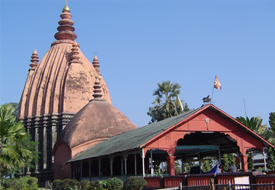 | 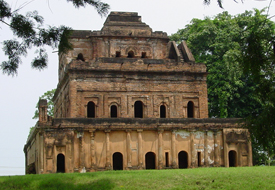 | 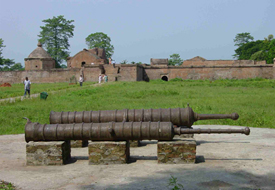 |
Sivasagar is surrounded by medieval tanks – locally called sagar (sea) for an indigenous technology that helps maintain the water level even during severe dry seasons. Not far away from the town at Charaideo are the maidams or the pyramid-like royal vaults. Each maidam has a domed superstructure covered by a hemispherical earthen mound. No less significant are the following archaeological sites.
The ruins of the door frame of Da-Parbatia Temple a few kms. from Tezpur town, is perhaps the finest and oldest specimen of sculptural or iconoclastic art in Assam. It's carving has the characteristics of the style of early Gupta School of sculpture. The door-jambs having two goddesses, Ganga and Yamuna, standing below with garlands in their hands in artistic pose and elegance are decorated with beautiful ornamental foliage.
Barely 40 kms. away from the sprawling metropolis Guwahati, on N.H. 52 Madan Kamdev is an enigma, a mystery, a marvel and in the words of Omar Khayam, "a veil past which I could not see". Very little is known about the origin of this magnificient archaeological ruins. Written history is almost silent on it, leaving wide room for conjectures and hypothesis. The ruins of Madan Kamdev scattered over a hillock dates back to the 9th and 10th centuries. Remnants of 12 temples were discovered here 35 years ago. Apart from Hindu deities, the ruins have erotic sculptures akin to Khajuraho in central India’s Madhya Pradesh state.
 | 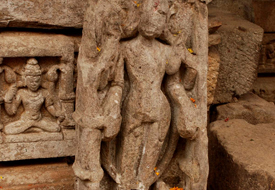 | 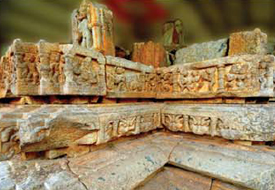 |
"Preserving the sweet memory of young lovers", Agnigarh or the rampart, surrounded by fire, is perhaps the most beautiful tourist spots in Tezpur. According to legend, Princess Usha, the only daughter of King Bana, was kept inside the palace which was surrounded by rampart of fire. The present Agnigarh, now only a hillock facing the mighty Brahmaputra, provides the tourist a soul touching panoramic view of both the river and Tezpur town.
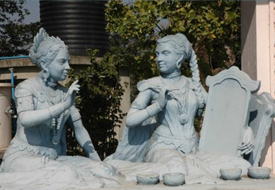 |  | 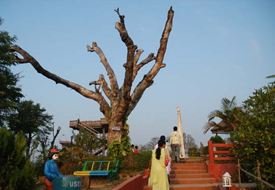 |
Suryapahar is located 136 km west of Guwahati is a unique archaeological site on a hillock sporting Hindu, Buddhist and Jain relics together. The site has hundreds of ancient engraved Shiva Lingas of various sizes, a series of Buddhist stupas and sculptures associated with Jain religious beliefs. Remains of planned houses and artistic bricks at Suryapahar have confirmed the long-held belief that a civilization thrived here centuries ago.
Deoparbat is close to Kaziranga National Park, Deoparbat is a hillock housing stone carvings and ruins of temples from the 8th and 9th centuries. The main Shiva temple here was destroyed in a major earthquake in 1897. The archaeological site adjoins the Deopahar Reserve Forest and is close to Garampani Wildlife Sanctuary on National Highway 39. Home to hoolock gibbons and golden langurs, the sanctuary derives its name from a hot spring.
Ambari excavations is located in the heart of Guwahati, close to the Dighalipukhuri tank, Ambari straddles two distinct cultural periods ranging from 7-12th AD and 13-17th AD. A ceramic industry dominated by kaolin ware, red ware and buff ware has been unearthed here. Chinese celadon ware and green glazed ware have also been found in the excavation.
The moidams are pyramid like burial mounds of members of the Ahom royalty. The best known are some 40 tombs at Charaideo, 30 km from Sivasagar town, which was the first capital of the Ahoms after Sukapha (1228-1268) established his kingdom there. At Hoolungapara, 16 km from Jorhat, is Lachit Moidam that preserves the remains of Lachit Barphukan (1622-72), the great Ahom general who defeated the Mughal forces in the Battle of Saraighat in 1671. Close to Jorhat are Raja Moidam, the tomb of king Purandar Singha, and Purnananda Buragohain Moidam, the tomb of a general near Tocklai.